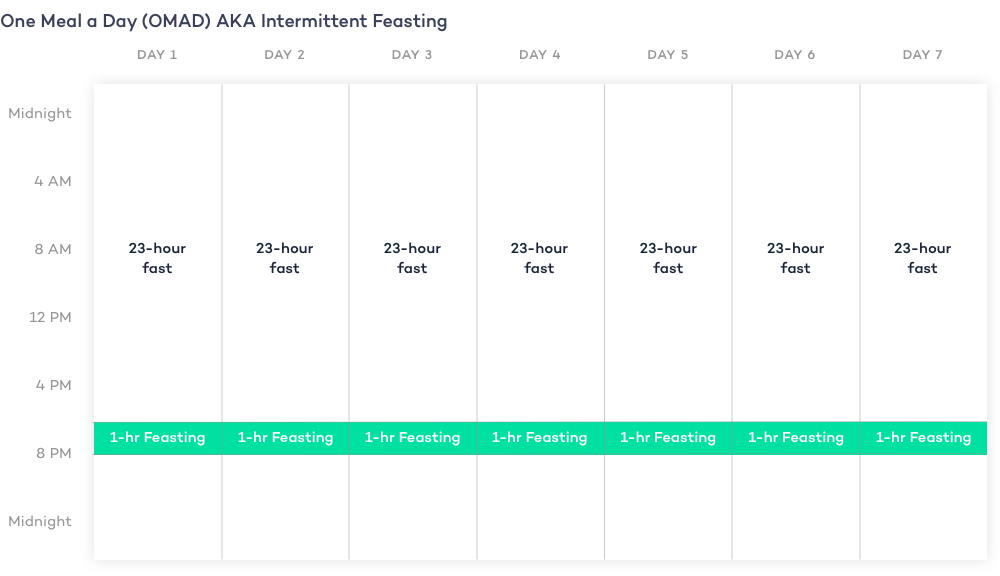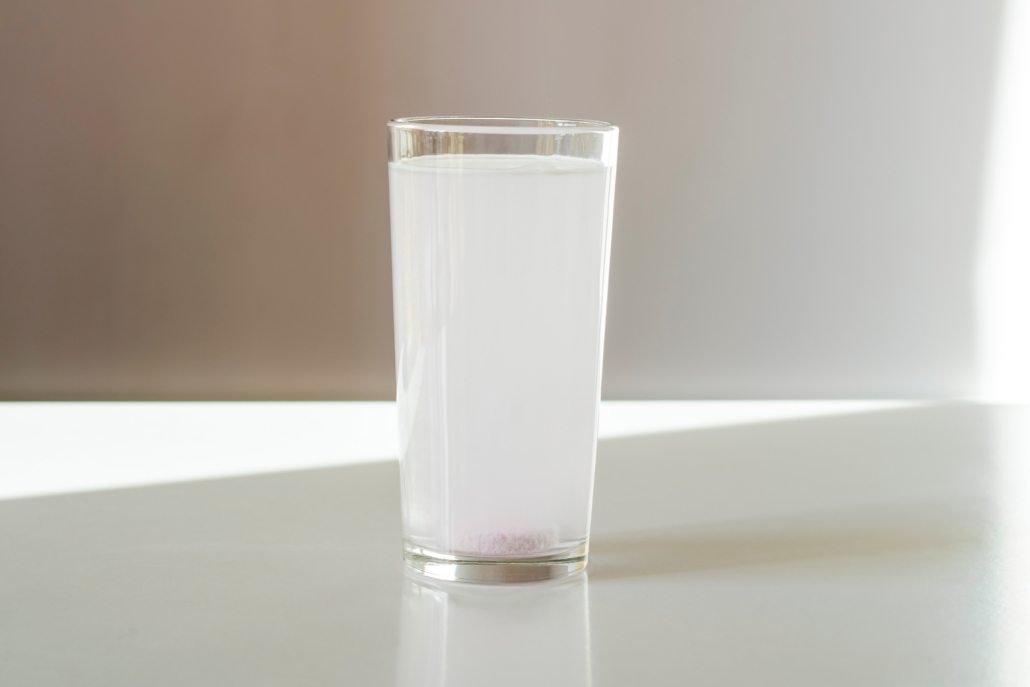We include products in articles we think are useful for our readers. If you buy products or services through links on our website, we may earn a small commission.
One Meal a Day Diet (OMAD): What it is, Benefits, and How to Do it

Table of Contents
Intermittent fasting (IF) is extremely popular, and there are many approaches to choose from. The OMAD (One Meal a Day) is one of the simplest, but it’s also one of the more extreme intermittent fasting methods.
In this article, we’ll take a deep dive into all things OMAD, with the goal of helping you determine if this intermittent fasting approach is right for you.
What is the OMAD diet?
OMAD is an acronym that stands for “one meal a day”.
In case this acronym feels familiar, no — OMAD is not to be confused with GOMAD, which refers to the practice of drinking a gallon of milk a day in order to gain muscle.
Most people use OMAD to lose weight and improve their body composition.
The concept of eating only one meal a day might seem extreme in the context of the standard American diet of three meals a day with snacks in between. But eating less frequent meals has been the norm throughout much of human history.
From 2 million to 10,000 years ago, humans were apex predators, feasting on large prey called megafauna, and then fasting until the next successful hunt. [1]
Fast forward to just a few thousand years ago, and fasting was still the norm. “The Romans believed it was healthier to eat only one meal a day,” food historian Caroline Yeldham explains to BBC News. “They were obsessed with digestion and eating more than one meal was considered a form of gluttony.” [2]
This historical precedent still leaves its mark on our genetics today. Being in a fasted state activates numerous evolutionarily beneficial responses: the brain thinks faster, blood vessels dilate, and muscles become more resistant to lactic acid. [3]
From an evolutionary perspective, these traits add up to being better hunters. It makes sense when you consider that the men and women who were better at hunting when they were hungry were able to survive and pass their genes onto us.
Conversely, failing to fast and staying in a fed state all the time can make us fatter, slower, and dumber. The science is clear that humans can thrive when faced with occasional food scarcity. [4]
How to Get Started on the Omad Diet
OMAD is a somewhat more intense version of the intermittent fasting protocols we’ve discussed elsewhere. This variety of IF could just as easily be called intermittent feasting, as it necessitates eating all your daily calories in one large meal.
OMAD Rules
OMAD requires fasting for roughly 23 hours a day. Within your one-hour eating window, you’re free to eat as much as you want. Most people prefer to keep the same eating window each day.
Though the OMAD diet has become popular partly due to the idea that “you can eat anything you want and still lose weight,” science tells us that it’s extremely important to refuel with healthy whole foods.
That’s because when you fast you stimulate cellular regeneration. Feeding these hungry new cells with high-carb processed junk that most people consume on a Standard American Diet, can cause cancerous lesions and inflammation.
OMAD Example
Most people on OMAD also prefer to place their eating window at mid-day, or near the end of the day, but not so late that it interferes with digestion before bed.
The chart below denotes an eating window from 7-8 pm and a fasting window from 8 pm to 7 pm the next day.

OMAD Tips
Since OMAD requires eating big meals, meal timing is especially important. Consider eating your one meal a day after finishing most of your activities. You wouldn’t want to eat a 3,000 calorie meal and jump right into a run or swim afterward, for example.
It’s also important to remember to eat enough on OMAD.
Most adults require 2,000+ calories a day to really thrive. Fitting this into one meal can be very difficult unless you’re eating energy-dense foods like beef or butter. Going too low in calories can damage your immune system, slow your thyroid, and make losing weight more difficult. [5][6]
Along the same lines, people with high-calorie requirements should avoid OMAD fasting. (More on how to know if this type of fasting is right for you later.)
Superfoods like salmon roe, and oysters, quality meat, eggs, and healthy fats make an excellent foundation for your OMAD eating plan.
Organ meat supplements are a great way to ensure you’re meeting all your micronutrient needs.
Omad Diet Benefits
The OMAD diet benefits are numerous. Below are just a few of its many highlights.
OMAD Diet Benefit #1: Weight Loss
OMAD can be a powerful way to lose weight quickly and sustainably. Most people find it blunts their appetite enough to make eating fewer calories almost effortless.
There’s a hormonal aspect to OMAD’s ability to promote weight loss, too. Being in a fasted state for 23 hours per day keeps ‘storage hormones’ like insulin (which turns blood sugar into fat) down to a minimum, making getting into fat-burning mode easy.
On OMAD, your body will be burning fat for 23 hours a day — and building muscle for one. Most people find this way of eating to be exceptionally good at preserving their muscle mass while they lose weight.
One study found that intermittent fasting preserved muscle mass better than an equally-low calorie ‘normal’ diet. [7] Muscle, in turn, can further assist with weight loss, since most muscles burn fat at rest. [8]
Contrast that with the standard American diet, which does a great job at elevating your blood sugar and preventing you from burning fat for fuel. No wonder most people who follow the SAD are “skinny fat” at best.
Your metabolic rate may also rise once you reach a fasted state. Contrary to popular wisdom, not eating seems to boost, not decrease, metabolism. Several studies show that fasting can speed metabolism by anywhere from 3.6 to 14%. [9]
OMAD also allows your body to produce ketones. These energy molecules like beta-hydroxybutyrate are produced fat and offer several clear health benefits. Ketones are especially great fuel for your brain where they help regulate neurotransmission and other aspects of cognitive health. [10]
OMAD Diet Benefit #2: Reduced Inflammation
Chronic inflammation has been implicated in virtually every disease state. Experts believe it’s behind most of the chronic diseases that run so rampant today.
Thankfully, fasting can directly reduce inflammation. The way it does this is simple: during a fast your body isn’t distracted by digestion and nutrient assimilation and can instead focus on reducing inflammatory markers. Even your gut lining can benefit from getting a bit of a break; it spends a fast regenerating, which further reduces inflammation. [11]
Getting into a ketogenic state can also reduce inflammation since ketones nourish your mitochondria and promote new mitochondrial generation. This anti-inflammatory, anti-aging process is called mitophagy. [12]
OMAD’s ability to reduce inflammation is likely why it seems to extend lifespan. Roden studies have found that eating less frequently can increase lifespan by as much as 80 percent. [13]
OMAD Diet Benefit #3: Improved Mental Health
Studies show that extended fasts can increase your production of neurohormones that directly improve mental health.
One such hormone stimulated by fasting, Brain-Derived Neurotrophic Factor (BDNF), is so neuroplastic that Harvard neuropsychiatrist John J. Ratey calls it “Miracle-Gro for the brain.” Increased BDNF levels have been correlated with improved mood, better cognition, and increased creativity. [14]
Many people find that OMAD keeps them feeling sharp throughout the day, resulting in yet another layer of mental benefits. If you tend to get sleepy and demotivated after your ‘healthy’ lunch, the OMAD diet presents an easy solution: just skip it!
OMAD Diet Benefit #4: A More Youthful Appearance
OMAD has also become fairly renowned for its ability to turn back the biological clock. Many people report that their skin becomes plumper and more vibrant following daily fasts. And recent research indicates that this isn’t just some sort of hunger-induced placebo effect.
One recent study found that fasting for 24 hours boosted anti-aging hormones like human growth hormone (HGH) by between 1300 and 2000 percent. [15]
This special hormone plays a vital role in structuring muscle fibers, connective tissues, and the skin. It’s likely responsible for the smoothed-out wrinkles and brighter glow many people on OMAD notice when they look in the mirror. [16]
OMAD Diet Benefit #5: Dietary Freedom!
This last benefit is more of a practical one. OMAD offers busy people tremendous dietary and logistical freedom. With the OMAD diet there’s no more waking up early to cook breakfast…no more settling for crappy lunches at work…no more worrying about eating on the road.
All you have to do is ensure you eat one big well-formulated meal a day — wherever and whenever you want. Many people find OMAD mentally freeing, too, since they’re not distracted by food during the day.
But again, this only works when you’re fueling up with enough calories from healthy whole foods. Ordering half the menu at Mcdonald’s isn’t going to cut it.
Drawbacks to the OMAD Diet and How to Avoid Them
The OMAD diet may be impractical for some people. Its top drawbacks include undereating, too-high stress hormones, and potential problems with fertility. People with diabetes may also need to eat more frequently than OMAD allows for.
Potential Drawback: Undereating
Eating between 1,500 and 2,000 calories within an hour-long eating window can be challenging. Especially if you’re aiming for a low-fat or plant-based approach.
Choosing nutrient-dense meat and healthy fats make OMAD much more viable.
If you’re super active or have otherwise high caloric demands, OMAD is probably not for you. It’s just too likely to lead to undereating. (That being said, it does work for former NFL and MMA star Herschel Walker.) [17]
Potential Drawback: Stress Hormones
Making the shift to OMAD can trigger your body to undergo hormonal changes. When making the transition your body may produce stress hormones like cortisol to mobilize protein for use as fuel [18].
Women may be especially susceptible to cortisol-related changes. If OMAD feels too stressful there are a number of alternative intermittent fasting strategies for women.
Women who are pregnant or trying to become pregnant may want to wait to try OMAD. Intermittent fasting may pose hormonal and energy-deficiency problems that are not worth the risk. Male fertility, on the other hand, doesn’t seem to be negatively affected by fasting. [19]
Is the Omad Diet Right for you?
So…is OMAD right for you? If any or all of the following things apply, then it probably is:
- You’re over 50
- You enjoy big meals
- You suffer from brain fog
- You’re trying to lose weight
- You have a ‘slow metabolism’
- You have chronic aches and pains
- You’re trying to reach new levels of performance at work or school
If, on the other hand, if check the following categories, then OMAD may not be a good fit for you:
- You’re underweight
- You’re young and active
- You can’t stomach big meals
- You have a ‘fast metabolism’
- You’re nursing, pregnant, or trying to become pregnant
- You struggle with high cortisol or similar hormonal problems
Omad Diet Meal Plan
Eating OMAD diet meals, as mentioned above, means eating big meals.
It’s important to ensure you’re getting at least 1500 calories a day.
The following OMAD meal plan is designed to make it easier to eat big. Enjoy!
| Day 1 | Day 2 | Day 3 | Day 4 | Day 5 | Day 6 | Day 7 | |
| Meal | King slamon and eggs with creme fraiche, butter. Coconut manna for dessert | Beef short ribs Russet potato Asparagus with tallow Berries with heavy whipping cream
| Greek frittata with feta cheese, pork belly, mushrooms, butter. Berries with creme fraiche for dessert | Tuna Salad with homemade olive oil mayo. Deviled Eggs with anchovies. Macadamia nuts. Kiwi | 16 oz Bison burger with 2oz liver blended in, swiss cheese, and creme fraiche sweet potatoes with butter | Arctic Char with butter and parmesan Asparagus with tallow and parmesan Berries with creme fraiche for dessert. | Salmon Belly with creme fresh, oysters. Dark chocolate for dessert |
OMAD: The Takeaway
OMAD-style intermittent fasting (or is it feasting?) is a time-tested way to activate cellular renewal, improve body composition, and boost vitality.
Its simplicity is its greatest virtue. And when combined with the right foods, it can help you kick your carb addiction and regain metabolic control. OMAD can be especially effective when combined with keto.















